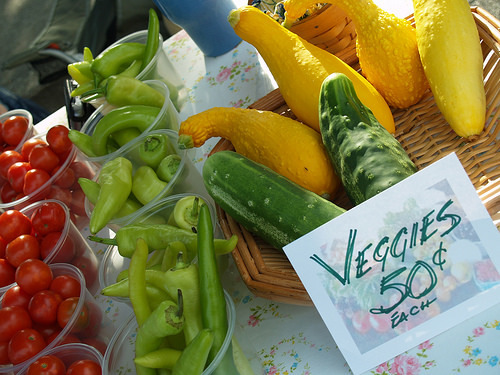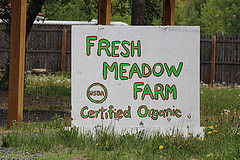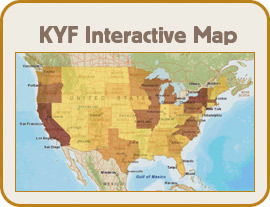Know Your Farmer, Know Your Food Newsletter - Issue 1
USDA Office of Communications sent this bulletin at 06/26/2015 01:23 PM EDTHaving trouble viewing this email? View it as a Web page.


Welcome!
In the past, you’ve expressed interest in learning about the Know Your Farmer, Know Your Food initiative (KYF2) and other U.S. Department of Agriculture activities that support local and regional food systems. This newsletter will provide periodic updates about relevant resources and opportunities across USDA – and even some news from our federal partners! Included in this inaugural issue are several new financial resources, announcements, and highlights from the USDA blog.
We expect that the newsletter will arrive in your inbox periodically. If you have any suggestions for content or would like to reach the KYF2 Team, please email knowyourfarmer@usda.gov.
Have a great summer!
-The KYF2 Team
Happening Now:
Why should local food producers get involved in FSA County Committees? Join the Call June 29th!
FSA County Committee nominations are open now through early August. Nationwide, there are approximately 7,800 farmers and ranchers serving on FSA county committees. FSA county committees make important decisions on disaster and conservation programs, emergency programs, commodity price support, and other agricultural issues.
Join a call on Monday, June 29th at 3pm ET with three local food farmers who will explain their participation on County and State level FSA committees and answer questions about how nomination and voting works, and why you should be involved.
The conference call number is: 888-844-9904. Participant Code is: 4804675.
Farmers do not need to be actively participating with any USDA program in order to vote or run for a three-year FSA committee term, but their farms must be registered with FSA and they must live in the voting district. Farmers who rent both land and house are also eligible. Farmers and ranchers may nominate themselves or others to sit on the county committees. Organizations representing minorities and women also may nominate candidates. The nomination form and other information about FSA county committee elections are available on the FSA elections website.
Tools and Resources:
When was the last time you looked at the KYF2 Compass Map? It's now updated and easier to use! The Compass Map shows USDA and other federal investments in local food in your community and around the country – plus data on farmers markets, food hubs, and more. Zoom in on your city or town or search the map by keyword to see how other communities are using federal resources to do innovative work on local foods. Explore this comprehensive tool and other resources from USDA on the Know Your Farmer, Know Your Food website.
USDA Funding: Opportunities Currently Open!
- Value-Added Producer Grants (VAPG) – Deadline: Paper application postmark - July 7, 2015; electronically via Grants.gov - July 2, 2015. Value-added processing and marketing helps farmers and ranchers receive a higher portion of the retail dollar. These grants are open to individual or group applicants in both rural and urban areas to support planning activities, such as developing a business plan, as well as working capital. Grants require a 50% match in funds or in-kind resources.
- Rural Business Development Grants (RBDG) – Deadline to apply varies by state. These are competitive grants designed to benefit small and emerging businesses in rural areas through targeted technical assistance, training, and other activities. Public entities, cooperatives and nonprofits are eligible to apply.
- Organic Certification Cost Share Programs - Cost share programs cover a wide range of certification-related expenses and cover 75 percent of the cost of organic certification, up to a maximum of $750 annually. Producers and businesses can apply for reimbursement through their state agencies.
- Microloans are direct farm operating loans with a shortened application process and reduced paperwork designed to meet the needs of smaller, non-traditional, and niche type operations. The maximum Microloan is $50,000, which may be used for farm equipment, livestock and feed, minor improvements or repairs to buildings, refinance of certain farm-related debts, and other operating expenses. Find your local FSA office.
- Rural Cooperative Development Grants (RCDG) – Deadline: Paper application postmark - July 30, 2015; electronically via Grants.gov - July 27, 2015. The primary objective of the RCDG program is to improve the economic condition of rural areas by assisting individuals and businesses in the startup, expansion or operational improvement of rural cooperatives and other mutually-owned businesses through Cooperative Development Centers. Nonprofit corporations and institutions of higher education are eligible to apply for this program. Public bodies, for-profit business, and individuals are not eligible. If you have questions, you can contact your nearest Rural Development Office.
Find your local farmers market, CSA or food hub – and make sure your operation is listed!
 What a great time of year to visit your local farmers market! From blueberries and strawberries to the first tomatoes, farmers markets are full of fresh ingredients that you can use in your favorite summer recipes. The USDA’s Agricultural Marketing Service maintains four Local Food Directories online, including the National Farmers Market Directory, which includes 8,200 farmers markets and provides information on their locations, operating hours, and other details. But that’s not all – check out the other directories, and make sure that your operation is included:
What a great time of year to visit your local farmers market! From blueberries and strawberries to the first tomatoes, farmers markets are full of fresh ingredients that you can use in your favorite summer recipes. The USDA’s Agricultural Marketing Service maintains four Local Food Directories online, including the National Farmers Market Directory, which includes 8,200 farmers markets and provides information on their locations, operating hours, and other details. But that’s not all – check out the other directories, and make sure that your operation is included:
-
USDA’s National Community-Supported Agriculture (CSA) Enterprise Directory – A CSA is a farm or network of farms that offers consumers regular deliveries of locally-grown farm products during harvest season on a subscription or membership basis.
-
USDA’s National Food Hub Directory – A Food Hub is a business that actively manages the aggregation, distribution, and marketing of food products to multiple buyers from multiple producers, to strengthen the ability of these producers to satisfy local and regional wholesale, retail, and institutional demand.
-
USDA’s National On-Farm Market Directory – An On-Farm Market is a farm market managed by a single farm operator that sells agricultural products directly to consumers from a location on their farm or on adjacent property.
- USDA’s National Farmers Market Directory – Farmers markets feature two or more farm vendors selling agricultural products directly to customers at a common, recurrent physical location.
Running a Food Hub Technical Report Series
The USDA is releasing a new technical report series entitled, Running a Food Hub. Created under a cooperative agreement with Virginia FAIRS and Matson Consulting, the series offers new and existing food hubs valuable information on how to plan for success, address challenges, and achieve viability. The first report in the series, Running a Food Hub: Lessons learned from the field, details best business practices for starting or expanding a food hub, including operational profiles of several existing food hubs.
Announcements:
Interested in sourcing local food for your Summer Food Service Program site?
 Summer is a time of agricultural abundance. In most areas of the United States, local harvests peak in the warmest months, just as the school year draws to a close. Luckily for local farmers and kids that participate in school meal programs, an increasing number of sites operating USDA’s Summer Food Service Program (SFSP) are capitalizing on the season’s bounty to offer fresh, local foods and outdoor activities that help children develop healthy habits. Learn why summer meal programs are ripe for the incorporation of local foods and agriculture-based learning in USDA’s new Farm to Summer fact sheet and other resources on Farm to Summer.
Summer is a time of agricultural abundance. In most areas of the United States, local harvests peak in the warmest months, just as the school year draws to a close. Luckily for local farmers and kids that participate in school meal programs, an increasing number of sites operating USDA’s Summer Food Service Program (SFSP) are capitalizing on the season’s bounty to offer fresh, local foods and outdoor activities that help children develop healthy habits. Learn why summer meal programs are ripe for the incorporation of local foods and agriculture-based learning in USDA’s new Farm to Summer fact sheet and other resources on Farm to Summer.
Organic NY brings together buyers and producers of organic products
 On June 2, 2015, USDA joined producers, organic companies and service providers at the Chester Agricultural Center in the Hudson Valley of New York to discuss opportunities in the region’s organic market. Over 100 attendees came together to discuss how to increase the region’s supply of high-quality organic agricultural products. USDA representatives presented a range of resources, including conservation incentives, crop insurance, microloans and value-added grants. The group then had an open discussion to identify areas that work well, common challenges, and opportunities for improvement. The event was part of USDA’s commitment under Secretary Vilsack to provide the thriving organic sector with the tools and services it needs to continue to grow.
On June 2, 2015, USDA joined producers, organic companies and service providers at the Chester Agricultural Center in the Hudson Valley of New York to discuss opportunities in the region’s organic market. Over 100 attendees came together to discuss how to increase the region’s supply of high-quality organic agricultural products. USDA representatives presented a range of resources, including conservation incentives, crop insurance, microloans and value-added grants. The group then had an open discussion to identify areas that work well, common challenges, and opportunities for improvement. The event was part of USDA’s commitment under Secretary Vilsack to provide the thriving organic sector with the tools and services it needs to continue to grow.
Local Food Happenings from the USDA Blog:
With USDA Help, Farmers Market Goes Uptown
The City Council of Greenwood, South Carolina voted to approve construction bid for a new multi-functional farmers market. USDA supports partnerships across the country to create greater economic impact for rural Americans. USDA’s Agricultural Marketing Service (AMS) Architect Fidel Delgado got involved in providing technical assistance for the project.
School garden Brings Local Food, Agriculture Education into Students’ Lives
Delaware’s William Penn High School includes a 117 acre farm. A Farm to School Grant is helping the school strengthen its farming program and help students learn more about sustainable farming, conservation, and healthy communities.
The University of the District of Columbia (UDC) is taking on urban agriculture with the Miurkirk Agricultural Experimentation Station, a research garden, a farmers market and plans to develop a commercial kitchen.
Mobile Farms Move into Urban Settings
A pair of avid East Coast gardeners started looking for non-traditional ways to grow their own crops in the urban setting of Marlborough County, Massachusetts; with the help of their savings and a USDA Farm Service Agency (FSA) microloan, they were able to purchase a repurposed freight container that is tailored for hydroponically growing vegetables.
Know Your Farmer, Know Your Food Initiative Celebrates 6 Years
Six years ago this month, KYF2 held the first meeting of its Task Force, made up of representatives from across the Department. The first in a series of blogs recognizing long-time Task Force members, this blog profiles Jill Auburn, National Program Leader at USDA’s National Institute of Food and Agriculture (NIFA) and manager of the Beginning Farmer and Rancher Development Program.
The University of the District of Columbia’s (UDC) Muirkirk Agricultural Experimentation is located about 20 minutes north of the school’s D.C. campus. The program is heavily involved in both the research and extension aspects of urban agriculture.
Growing with the Times, Expanded USDA Farmers Market Opens for 20th Season
On Friday, May 1st, Secretary Tom Vilsack kicked off the 20th season of the USDA Farmers Market. It was quite a celebration! The market has undergone a major redesign and expansion this year to make room for twice as many vendors as in the past. This year the market is especially excited to host the “USDA Farmers Market at Night” from 5 p.m. to 8 p.m. every third Friday.
Stay Connected:
Questions, comments? Email knowyourfarmer@usda.gov. Share your local food stories using the hashtag #localmade.
Want to highlight or connect with women in agriculture or new and beginning farmers on social media? Use #womeninag or #newfarmers.
Learn more about how USDA supports new farmers and organic agriculture!
You are subscribed to Local and Regional Food Systems for USDA Office of Communications.


